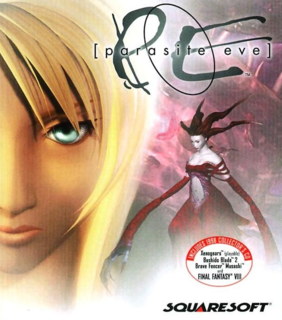The Mitochondria are running wild in this RPG-action-survival horror title. Parasite Eve is decent, but not great.
You take the role of Aya Brea, an NYPD officer on her night off. After deciding to go see an opera, Aya witnesses a hellish display as the entire audience (except her, of course) spontaneously combusts into flames and is reduced to ashes in a matter of minutes. It is soon obvious that the female singer, performing her solo at the same moment, is the one responsible. Confronting her, she introduces herself as Eve, and claims that the time for the mitochondria to become the dominate life form on Earth has come. Soon after her little lecture, Eve changes into a winged creature and escapes the theater. Following Eve into the sewers, Aya encounters her first enemy of the game- a huge rat. It seems that the mitochondria inside the animals are mutating them into huge, disfigured monsters.
The combat in "parasite Eve" is a strange mish-mash between classic RPG turn based combat, and other survival horror games real-time combat. After entering "battle mode", Aya is free to run around the combat area, dodge enemies' attacks and wait for her ATB (Active Time Bar) to fill up. Once it's done, Aya can choose between attacking, using an item or using her "Parasite Energy" (more about that later). Each action will deplete the ATB, and Aya will have to wait for it to refill again. Each combat-zone is bound within a perimeter of unseen barriers until the battle is over, and the only way to end a battle is to defeat all the enemies within this perimeter (Aya can escape from most of the battles, losing experience points in the process, but this ability is lost towards the end of the game).
Except for the combat, "Parasite Eve" has a few other RPG elements. After every battle Aya gains experience points that can be used to upgrade her weapons and "Parasite Energy" abilities, make the ATB fill up quicker, or increase the inventory space. The "Parasite Energy" is sort of a magical ability Aya gains through her mutating mitochondria. Once every few levels a new power is unlocked. The PE powers include Heal (guess what this power does), Haste (makes Aya faster), Energy Shot (a powerful blast of energy) and Confuse (renders an enemy helpless for a few moments). There are a few other useful powers, but I won't give it all away.
Although heavy on the combat, "Parasite Eve" has some puzzle-solving aspects, but most of them are hunting for keys and keycards. There is one puzzle that involves repairing a busted generator, but that's as creative as it gets. What is unique about the game is it's variety of enemies and environments. Every new mutant Aya encounters is more grotesque and more terrifying than the previous one. There are huge spiders, sewer gators, polar bears and even dinosaurs. Environments include the aforementioned sewers, a police station, a museum and central park; each one with its own set of enemies.
The visuals are pretty impressive for a game released in 1998. The in-game graphics are good with well conceived character and enemy models. Most other survival horror games released at the time had pre-rendered, static backgrounds, but the backgrounds in "Parasite Eve" are more than that. Although still pre-rendered, the new touch is the animation seen in some of the backgrounds. Trees will move in the wind, lights will flicker on and off and water will shimmer and splash. The FMV sequences are amazing, even by today's standards; light effects and explosions are beautiful, and the movement of the characters is fluent. The sound is even better than the graphics. The music is a nice combination of techno music with electric guitar rock; in some segments the music will tune down a bit to a melodic piano track, but only to pick up again as soon as Aya encounters an enemy. There are no voice actors in the game at all, and every dialog is presented by text only, which can become a little tedious over time.
Unfortunately, good graphics and sounds are not enough to make a good game. "Parasite Eve" suffers in almost every other department, starting with gameplay and ending with the dialog and script. Although the combat is a new and refreshing take on the classic RPG system, it is really annoying to keep stumbling upon enemies in what is familiar as "random encounters". While wondering around, looking for a key or the right place to go to, it is not uncommon to come across the same enemies in the same spots over and over again. It's a great way to earn more experience points and items, but it slows down the pace of the game to a crawl (which might have been the developer's intention, since the game is criminally short). Aya's control is pretty good, except the fact that she runs like a stoned snail, not to mention her even slower walking pace (you have to hold down a button to make her run).
Overall "Parasite Eve" is a decent survival horror title, with just a little too much action. The good graphics and sound are not enough to compensate for the gameplay issues, but if you missed out on this game, and own a PlayStation, give it a go. If you didn't like other survival horror titles, than this one won't change your mind, even if you do like RPGs, so basically "Parasite Eve" is a game for fans of the genre only.

